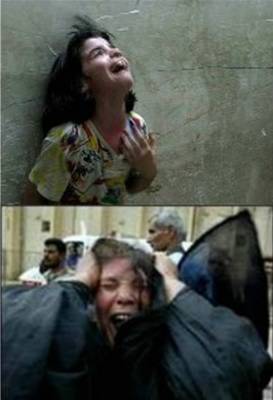Saturday, July 09, 2011
US ambassador in Hama: how Anthony Shadid covered it
Now this is the account of Anthony Shadid: "A video posted to YouTube captured a scene unusual for an American diplomat in the Arab world, where resentment at American support for authoritarian rulers runs deep. In Hama, crowds chanting “People want the fall of the regime” cheered what appeared to be Mr. Ford’s vehicle, and some protesters tossed flowers on its hood. In the background was a huge banner that said, “Syria is free, down with Bashar al-Assad.”" First, would Anthony Shadid dare cover something that is damaging to Israel on the bases of a video posted on YouTube? What do you think? For any news coverage relating to Israel, the New York Times' editors require standards and scrutiny tougher than those applied on PhD dissertations by committee members (at least in the old days). Yet, for coverage of Iran and Syria, the New York Times applies the most lenient and least reliable standards. Now here is the video in question. Watch it. It seems that Anthony assumed too much from a few minutes of video. Anthony says: "what appears to be Ford's vehicle". Exactly. The car is nondescript. How on earth would protesters know that this is the US ambassador's car? And there are no cars going through the tens of thousands of demonstrators in Hama. This is not going through the demonstration for sure. Secondly, the Syrian people don't know what Mr. Ford looks like. He is not visible at all, and is not recognizable (except in Hama--if you believe the account in the Shadid article). So Mr. Ford is not recognizable anywhere in the world (I did not know what he looks like until yesterday), except in Hama and Dayr Az-Zur, for some inexplicable reason. Thirdly, the account of the ambassador being greeted by protesters first appeared not in news sites but in the account of the US Department of State's spokeswoman. That should have at least made Shadid express some healthy skepticism. Fourthly, there is a history of American staging of public spectacles: from Operation Ajax in Iran in 1953, to the most fake staging of a spectacle--the topping of Saddam's statue in Firdaws Square in Baghdad when US soldiers provided old style Iraqi flags thinking that the Iraqi people would abandon the Saddam flag which has "God is Greater" on them. Fifthly, look at the video itself. Judge for yourself. It is most fishy. The car does not look like the fancy motorcade of a US ambassador in an an Arab country: it is a normal vehicle. There is no way for protesters in Hama to know that this is a US diplomat's car. And how would the crowd know it is the ambassador? And if you look at the video, the people around the car appear more like the local goons that US embassy hires for security. In Lebanon, the local hired goons were graduates of the death squads of the Lebanese Forces, by the way. And the "protesters" in the video (which zoomed closely in and it concluded with a close up of the face of the ambassador to suspiciously prove to people that it is indeed the Mr. Ford) seemed to be protecting the car more than anything else. They were strategically protecting the car. Otherwise, the whole scene is very weird: there are according to news accounts, several hundred thousands protesters in Hama, and it is not possible that his car went through that crowd. We know how careful US diplomats are about their security, especially the security of the ambassador. Sixthly, how did the people in Hama arrange for the flowers (bushes really) to be tossed on the car? Or do people in Hama protest with trees in their hands? Seventhly, this is not only a staged event for political purposes, there is also a professional reason. Mr. Ford came under criticisms in Congress for visiting Jisr Ash-Shughur so he had to play John Wayne in another city. Enjoy.








